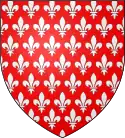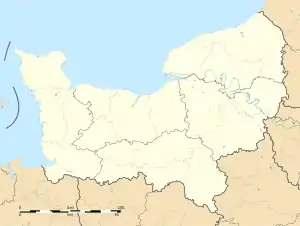Carrouges
Carrouges (French pronunciation: [kaʁuʒ] ⓘ) is a commune in the Orne department in north-western France.[3]
Carrouges | |
|---|---|
 The chateau in Carrouges | |
 Coat of arms | |
Location of Carrouges | |
 Carrouges  Carrouges | |
| Coordinates: 48°34′06″N 0°08′40″W | |
| Country | France |
| Region | Normandy |
| Department | Orne |
| Arrondissement | Alençon |
| Canton | Magny-le-Désert |
| Intercommunality | Pays fertois et Bocage carrougien |
| Government | |
| • Mayor (2020–2026) | Pierre Chivard[1] |
| Area 1 | 8.58 km2 (3.31 sq mi) |
| Population | 630 |
| • Density | 73/km2 (190/sq mi) |
| Time zone | UTC+01:00 (CET) |
| • Summer (DST) | UTC+02:00 (CEST) |
| INSEE/Postal code | 61074 /61320 |
| Elevation | 240–361 m (787–1,184 ft) (avg. 335 m or 1,099 ft) |
| 1 French Land Register data, which excludes lakes, ponds, glaciers > 1 km2 (0.386 sq mi or 247 acres) and river estuaries. | |
The inhabitants are known as Carrougiens and Carrougiennes.[4] The town is home to a castle (Château de Carrouges), built in the 14th century by Jean de Carrouges and restored after the Hundred Years War.
History
In the Middle Ages, Carrouges was part of the deanery of Asnebec. In 1490, under King Charles VIII, Jean de Blosset, Lord of Carrouges and grand marshal of Normandy, founded on his land, with its castle, a college (dedicated to Our Lady of Good Comfort) six canons payments the appointment of the lord who was also the collateur profits. These payments were estimated in 1698 to 200 pounds in Memory of the General Alençon by the intendant, M. de Pommereuil. It is also stated in 1698, that a court called "breadbasket tax" (related to gabelle paid on the salt) was located in Carrouges.
During the French Revolution of 1789, the town was called "Carrouges-la-Montagne". In August 1944, occupied by German forces, the city was liberated by the troops of the 3rd U.S. armored division, following the deeds of Mayor Geslain, who after being released from the German soldiers who had arrested him, indicated the positions of the Germans to the Americans.
Notable buildings and places
La Ferme Ornée de Carrouges is a public garden in the style of a Ferme ornée, that is split into seven different gardens.[5]
National heritage sites
The Commune has 2 buildings and areas listed as a Monument historique.[6]
Notable people
- Jean de Carrouges (1330-1396), a 14th century knight was born here
- Pierre Jean Launay (1900-1982), a French writer was born here
- Michel Le Royer (1932-2022), a French TV and Film actor, who was born here
- Philippe Tranchant (born 1956), retired professional footballer was born here
Twin town
.svg.png.webp) Carrouge, Switzerland since 2000.[9]
Carrouge, Switzerland since 2000.[9]
References
- "Répertoire national des élus: les maires" (in French). data.gouv.fr, Plateforme ouverte des données publiques françaises. 13 September 2022.
- "Populations légales 2020". The National Institute of Statistics and Economic Studies. 29 December 2022.
- "Commune de Carrouges (61074) − COG Insee". www.insee.fr.
- Mairie de Carrouges, Ouest-France.fr.
- "La Ferme Ornée de Carrouges - Comité des Parcs et Jardins de France". www.parcsetjardins.fr.
- "Mairie de Carrouges et sa commune (61320)". Annuaire-Mairie. 26 April 2023.
- "Chapitre à Carrouges - PA00110757". monumentum.fr.
- "Château de Carrouges à Carrouges - PA00110758". monumentum.fr.
- "Carrouges a fêté ses vingt ans d'amitié avec Carrouge, le village suisse". Ouest-France.fr. 18 July 2023.